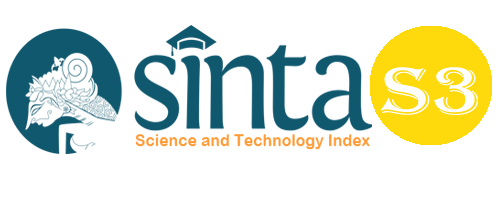‘HOTS’ in Reading Comprehension Questions of English Textbook for Secondary School (Revised Bloom’s Taxonomy study)
Abstract
The objective of this research was to picture out the implementation of the three up levels of the cognitive domain of revised Bloom’s Taxonomy used in the reading comprehension questions of Complete English for Cambridge Secondary 1, namely analyzing level, evaluating level, and creating level. Using the descriptive qualitative method, this study examined the questions in the reading comprehension questions of the Complete English for Cambridge Secondary 1 published by Oxford University Press – Oxford, United Kingdom, in 2016, arranged by Dean Roberts, Jane Arredondo, Annabel Charles, Alan Jenkins, & Tony Parkinson to categorize the reading comprehension questions into HOTs levels. A Revised Bloom's taxonomy-based checklist was utilized to gather, list, and classify these questions according to their cognitive levels. Then, for each level, the percentages were computed and finally described in account paragraphs. The findings of this study confirmed that Oxford University Press is a creditable publisher which accommodates HOTS in reading comprehension exercises based on the revised Bloom Taxonomy. The result showed that the most dominant level in the textbook was higher-order thinking skills (HOTS) was analyzing level in 50%. Then the evaluation reached 30% and creating reached got 20%. Additionally, this research has consolidated the confirmation base for using the Revised Bloom’s Taxonomy as a framework for revealing cognitive processes included in the high-order thinking skills.
Keywords
Full Text:
PDFReferences
Alief. A . 2016. An Analysis on English Textbook “Pathway To English” for the First Year Student of Senior High School based on 2013 Curriculum. School of Teacher Training And Education Muhammadiyah University of Surakarta.
Airasian, P. W., & Miranda, H. (2014). The Role of Assessment in the Revised Taxonomy. Theory into Practice, 41(4), 249–254.
Amali and Rozi. 2022. The Implementation of High Order Thinking Skills (HOTS) Assessment to Evaluate the Students’ Reading Comprehension Achievement. English Education Journal
Ary, D., Jacobs, L. C., Irvine, C. K. S., & Walker, D. (2010). Introduction to research in education. Cengage Learning.
Anderson, L. W., Krathwohl, D. R., & Bloom, B. S. (2001). A taxonomy for learning, teaching,and assessing A revision of bloom's taxonomy of educational objectives. New York; London: Longman.
Bloom, B. S. (1956). Taxonomy of educational objectives. Boston, MA: Allyn & Bacon.
Day, R.R., & Park, J.S. (2005). Developing reading comprehension questions. ERIC. 17 (1), pp.60-73.
Hayikaleng, Nuramah. 2018. The Effects Of Utilizing Youtube On Lots And Hots Questions In Reading Comprehension And Motivation Among Thai Students. Ph.D. Dissertation. Universiti Utara Malaysi.
Krathwohl, D. R. (2002) A revision of Bloom’s taxonomy: An overview. Theory into Practice College of Education, The Ohio State University. 41(4), 213-218.
Laila and Fitriyah. (2022). Analyzing Higher-Order Thinking Skills (Hots) Questions Of Reading Essay Tasks In Senior High School English Textbook. English Education Journal.
Lewis, A., & Smith, D. (1993). Defining Higher-Order Thinking. Theory into Practice, 32(3), 131-137.
Nuttall, C. (1996). Teaching reading skills in a foreign language (2nd ed.) with the chapter on testing reading by J. Charles Alderson. Oxford: Heinemann English Language Teaching
Panicker et all. (2019). Teacher Trainees’ Role in Implementing Higher Order Thinking Skills in The ESL Classroom. IJARIIE.
Rahman, Syukron A., Manaf Nor F. A. (2017). A critical analysis of Bloom’s taxonomy in teaching creative and critical thinking skills in Malaysia through English literature. English Language Teaching. 10 (9), 245-256.
Richards. (2001). Textbook Selection, Evaluation and Adaptation Procedures. International Journal of Language Learning and Applied Linguistics World (IJLLALW). 6(1). 2289-3245.
Rozi et all. (2021). The fullness of Higher Order Thinking Skills (HOTs) in Applied Science Textbooks of Vocational Schools. Journal of Physics: Conference Series
Sigh and Shaari. (2019). The analysis of Higher-Order Thinking skills in English reading comprehension tests in Malaysia. Malaysian Journal of Society and Space. 15 issue 1. 12-26
Seif, A. A. A. Q. A. (2013). Evaluating the Higher-Order thinking skills in reading exercises of English for Palestine grade 8. Asian Journal of Education and e-Learning. 1(1), 47-69
Setyowati., & Susanto. (2019). Promoting University Students’ Critical Thinking Skills Through Implementation of the Revised Bloom’s Taxonomy in Language Assessment: A Theoretical framework Perspective.181-184 (SoSHEC 2019) https://www.atlantis-press.com/proceedings/soshec-19/125926107
Setyowati,et al. (2020). The Implementation of “Test of Evaluating" and "Test of Creating" in the Assessment of Learning by EFL Lecturers in Pandemic Era. IDEAS Journal of Language Teaching and Learning, Linguistics and Literature Volume 8, Number 2, December 2020. DOI: 10.24256/ideas.v8i2.1520. http://ejournal.iainpalopo.ac.id/index.php/ideas/article/view/1686
Setyowati, Yulis. (2022). Critical Thinking within the Context of the Revised Bloom’s Taxonomy in Written Language Tests. Budapest International Research and Critics Institute-Journal (BIRCI-Journal) Volume 5, No 2, May 2022. DOI: https://doi.org/10.33258/birci.v5i2.5348. https://www.bircu-journal.com/index.php/birci/article/view/5348
Shah, M. M., et al. (2020). The Development Impact of PT. Medco E & P Malaka on Economic Aspects in East Aceh Regency. Budapest International Research and Critics Institute-Journal (BIRCI-Journal) Volume 3, No 1, Page: 276-286.
Siti, R.Y. (2018). Analysis of Students in Solving Higher Order Thinking Skill Question in Higher Education. (Thesis). State University of Jakarta. 32(2).
Suryanto. (2017). An investigation on English reading comprehension problems in Indonesian cultural contexts. The 1st International Conference on Education, Science, Art and Technology (the 1stICESAT. 200-205
Tayyeh, et all. (2021). An Analysis Of Reading Comprehension Questions In English Textbook " English For Iraq" According To Revised Bloom’s Taxonomy. Turkish Journal of Computer and Mathematics Education.
Toyoda, Etsuko. (2015). Relationship between Higher-Order Thinking Skills and L2 PerformanceElectronic Journal of Foreign Language Teaching.
Widiati, U., Rohmah, Z., & Furaidah. (2017). Buku Siswa Bahasa Inggris Kelas X Sma/Ma/Smk/Mk Edisi Revisi 2017. Kementerian Pendidikan dan Kebudayaan Republik Indonesia
Yu-hui, L., Li-rong, Z., Yue, N., (2010) Application of schema theory in teaching college students reading. Canadian Social Science 6(1), 59-65.Khanafi, I., Salafuddin, S., Abidin, M. Y., & Khamidi, A. N. (2013). Persepsi dan Transformasi Visi dan Misi Pada Civitas Akademika Stain Pekalongan. Jurnal Penelitian, 6(2). https://doi.org/10.28918/jupe.v6i2.229
Zaini, et al. (2019). An Analysis of Reading Comprehension Questions in English Textbooks for SMAN Kota Padang: HOTS. Proceedings of the Eighth International Conference on Languages and Arts (ICLA-2019)
DOI: https://doi.org/10.33258/birci.v5i3.6390
Article Metrics
Abstract view : 54 timesPDF - 52 times
Refbacks
- There are currently no refbacks.

This work is licensed under a Creative Commons Attribution-ShareAlike 4.0 International License.

This work is licensed under a Creative Commons Attribution-ShareAlike 4.0 International License.

_.gif)

















_.gif)



